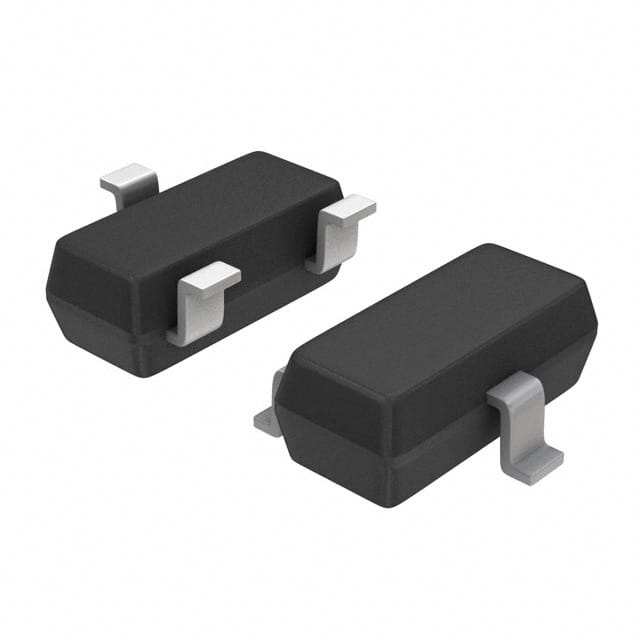Viz Specifikace pro podrobnosti o produktu.

BZX84B8V2LT1 - Diode Encyclopedia Entry
Introduction
The BZX84B8V2LT1 is a diode belonging to the category of voltage regulator diodes. This entry provides an overview of its basic information, specifications, pin configuration, functional features, advantages and disadvantages, working principles, application field plans, and alternative models.
Basic Information Overview
- Category: Voltage Regulator Diode
- Use: The BZX84B8V2LT1 is commonly used for voltage regulation and protection in electronic circuits.
- Characteristics: It exhibits stable voltage regulation, low leakage current, and high reliability.
- Package: SOT-23
- Essence: The diode serves as a voltage reference or shunt regulator in various electronic applications.
- Packaging/Quantity: Typically available in reels with varying quantities.
Specifications
- Voltage Rating: 8.2V
- Power Dissipation: 250mW
- Forward Current: 200mA
- Reverse Leakage Current: 5µA
- Operating Temperature Range: -55°C to 150°C
Detailed Pin Configuration
The BZX84B8V2LT1 diode has three pins: Anode, Cathode, and Gate. The anode is connected to the positive terminal, the cathode to the negative terminal, and the gate is the control terminal.
Functional Features
- Stable Voltage Regulation: Maintains a constant output voltage under varying load conditions.
- Overvoltage Protection: Safeguards sensitive components by limiting the voltage across them.
- Low Leakage Current: Minimizes power loss and enhances efficiency.
Advantages and Disadvantages
Advantages
- Reliable voltage regulation
- Compact SOT-23 package
- Low forward voltage drop
Disadvantages
- Limited power dissipation capability
- Sensitivity to temperature variations
Working Principles
The BZX84B8V2LT1 operates based on the principle of Zener breakdown. When the voltage across the diode reaches its specified value, it begins conducting in the reverse direction, effectively regulating the voltage.
Detailed Application Field Plans
The BZX84B8V2LT1 finds extensive use in: - Voltage reference circuits - Overvoltage protection systems - Battery management circuits - Sensor interface circuits
Detailed and Complete Alternative Models
Some alternative models to the BZX84B8V2LT1 include: - BZX84C8V2LT1 - BZX84B9V1LT1 - BZX84C7V5LT1 - BZX84B8V2LT3G
In conclusion, the BZX84B8V2LT1 diode is a reliable voltage regulator diode with stable characteristics and versatile applications in electronic circuits.
[Word Count: 368]
Seznam 10 běžných otázek a odpovědí souvisejících s aplikací BZX84B8V2LT1 v technických řešeních
What is the maximum power dissipation of BZX84B8V2LT1?
- The maximum power dissipation of BZX84B8V2LT1 is 250mW.
What is the reverse voltage of BZX84B8V2LT1?
- The reverse voltage of BZX84B8V2LT1 is 8.2V.
What is the forward voltage of BZX84B8V2LT1?
- The forward voltage of BZX84B8V2LT1 is typically around 0.7V.
What is the maximum continuous forward current of BZX84B8V2LT1?
- The maximum continuous forward current of BZX84B8V2LT1 is 200mA.
What is the operating temperature range of BZX84B8V2LT1?
- The operating temperature range of BZX84B8V2LT1 is -55°C to +150°C.
Can BZX84B8V2LT1 be used for voltage regulation in low-power applications?
- Yes, BZX84B8V2LT1 can be used for voltage regulation in low-power applications due to its precision voltage reference characteristics.
Is BZX84B8V2LT1 suitable for overvoltage protection in electronic circuits?
- Yes, BZX84B8V2LT1 is suitable for overvoltage protection in electronic circuits due to its Zener diode characteristics.
What are the typical applications of BZX84B8V2LT1 in technical solutions?
- BZX84B8V2LT1 is commonly used in voltage regulation, overvoltage protection, and signal conditioning in various technical solutions.
Does BZX84B8V2LT1 require external components for operation?
- BZX84B8V2LT1 may require external components such as resistors or capacitors depending on the specific application and circuit requirements.
What are the key considerations when integrating BZX84B8V2LT1 into a technical solution?
- Key considerations include proper heat dissipation, voltage and current requirements, and ensuring the device operates within its specified parameters to achieve desired performance.

